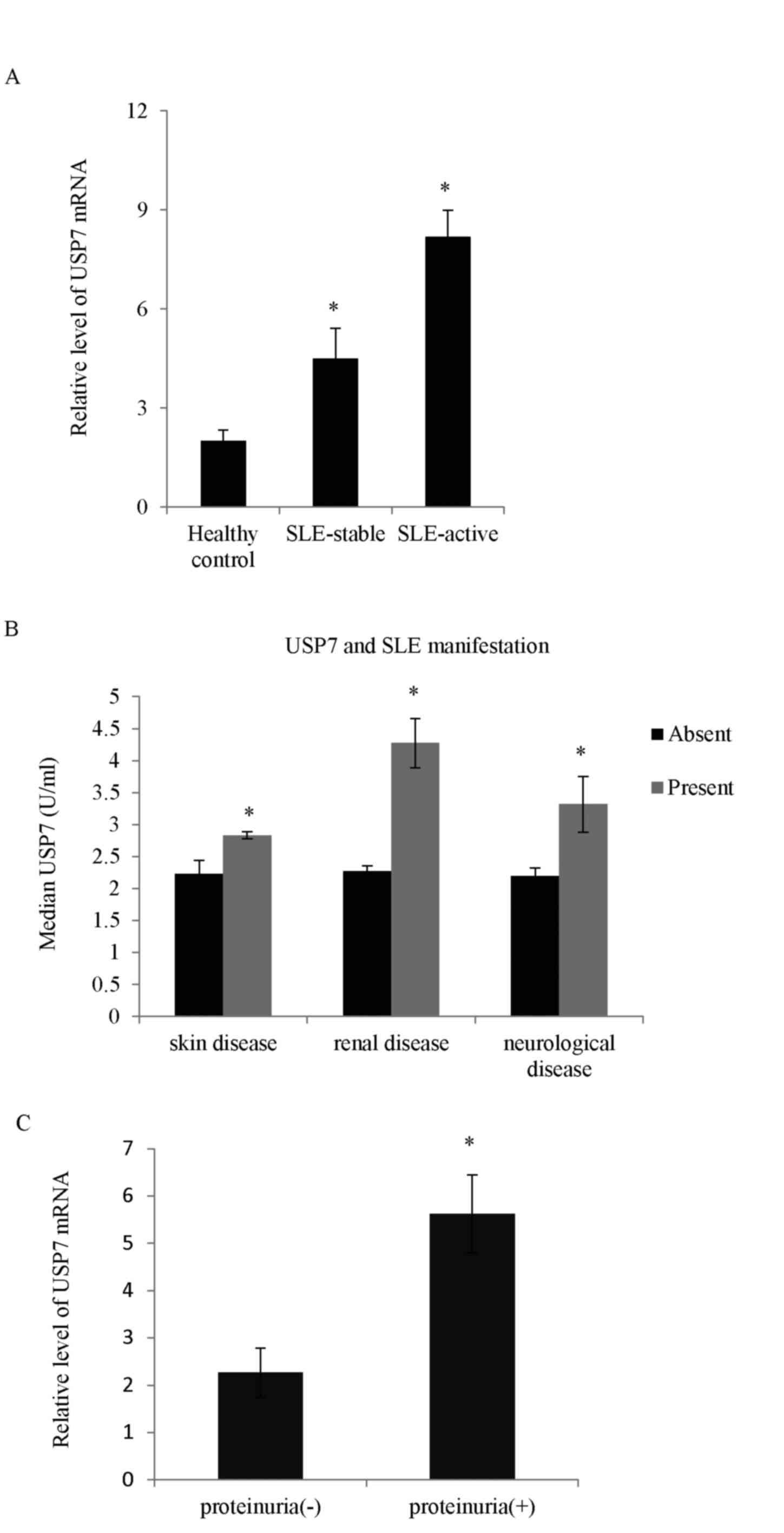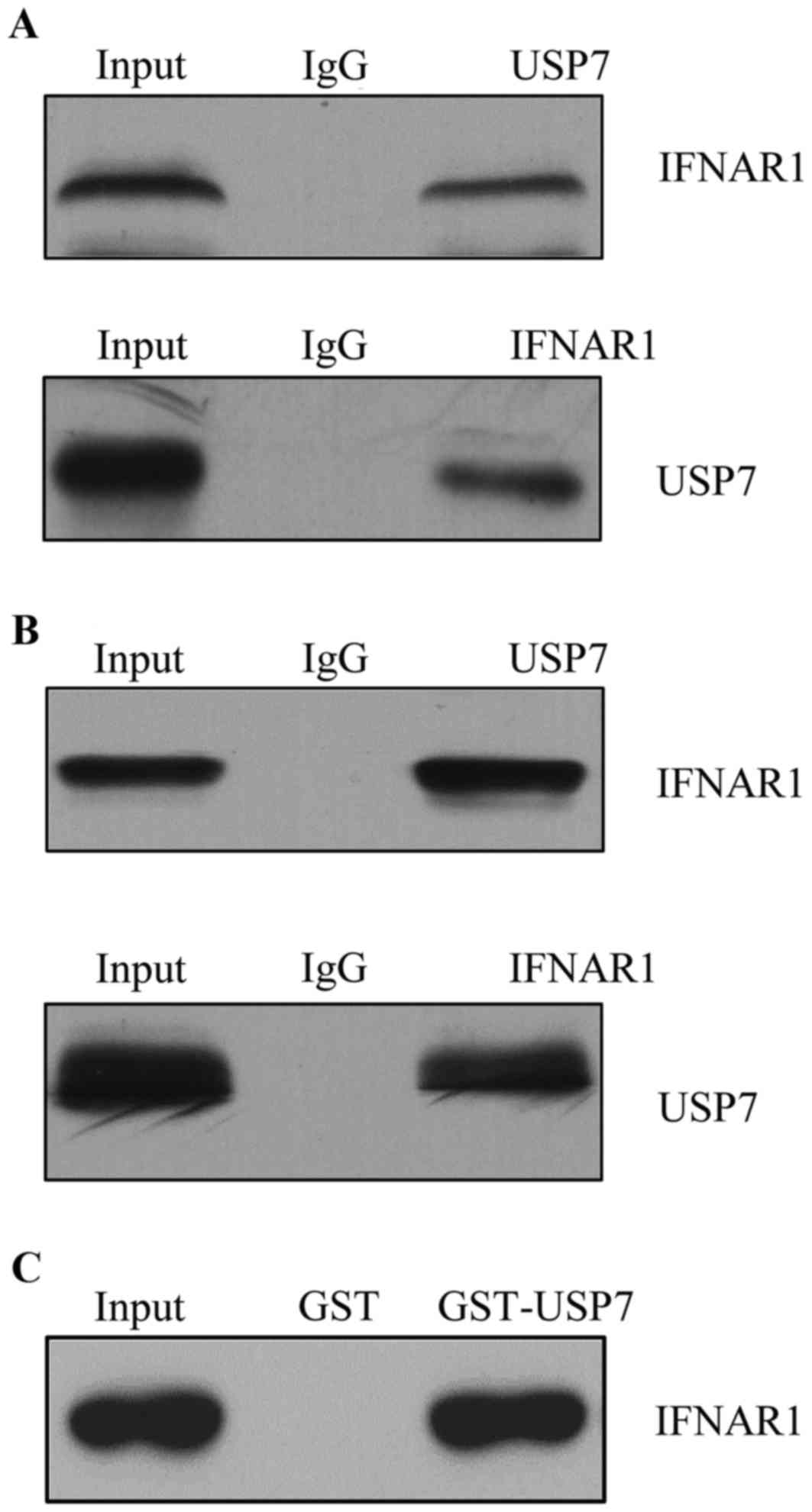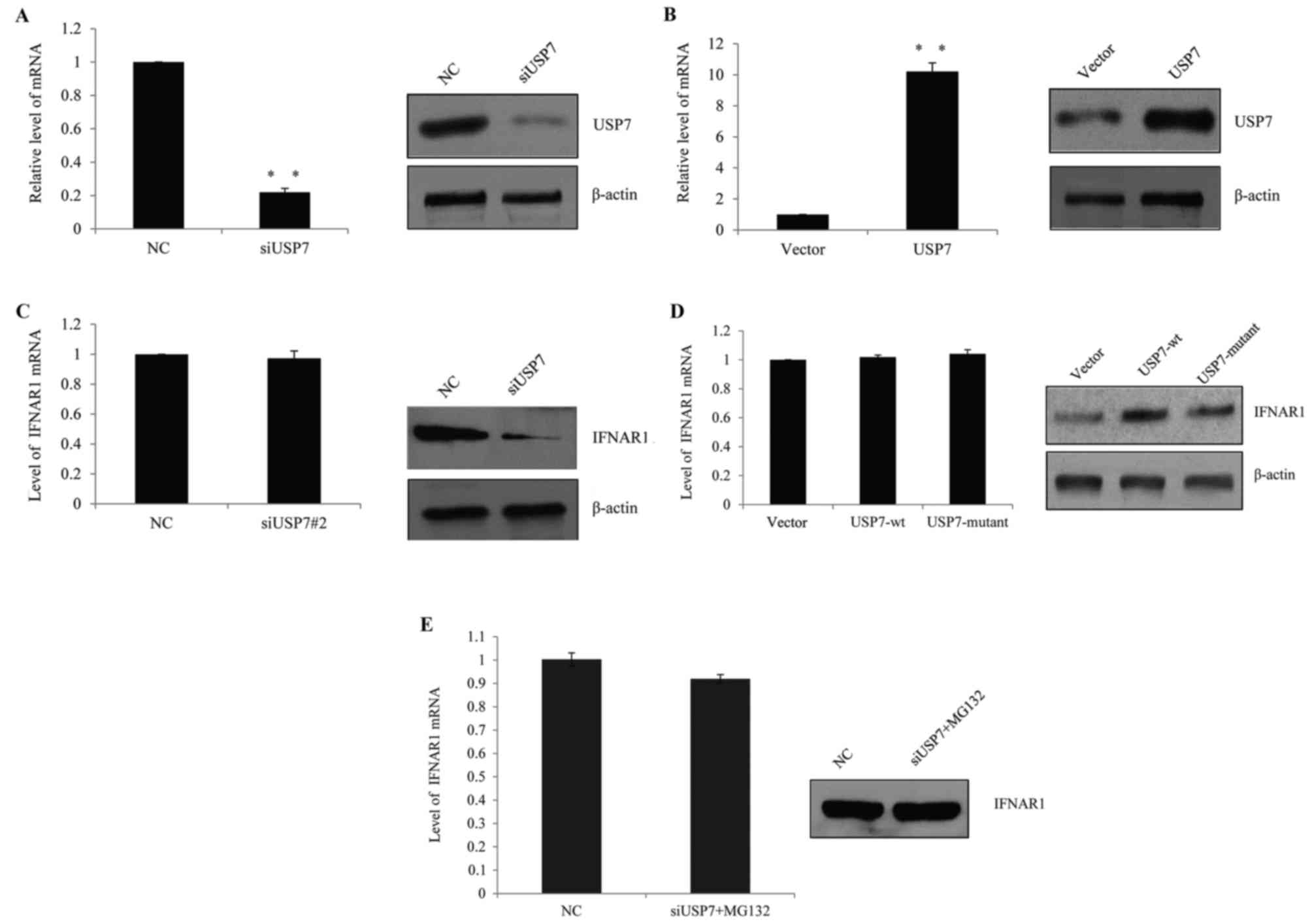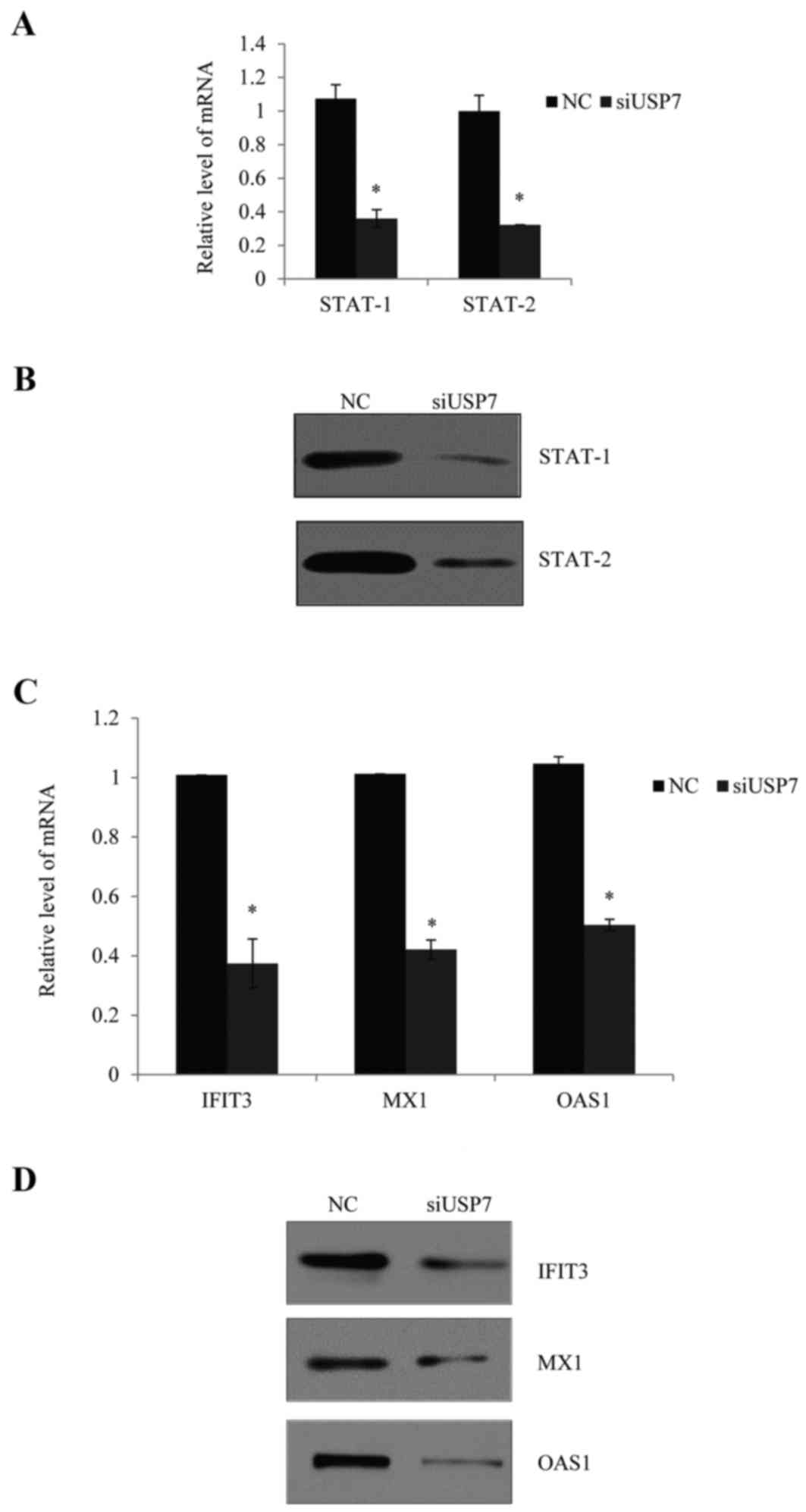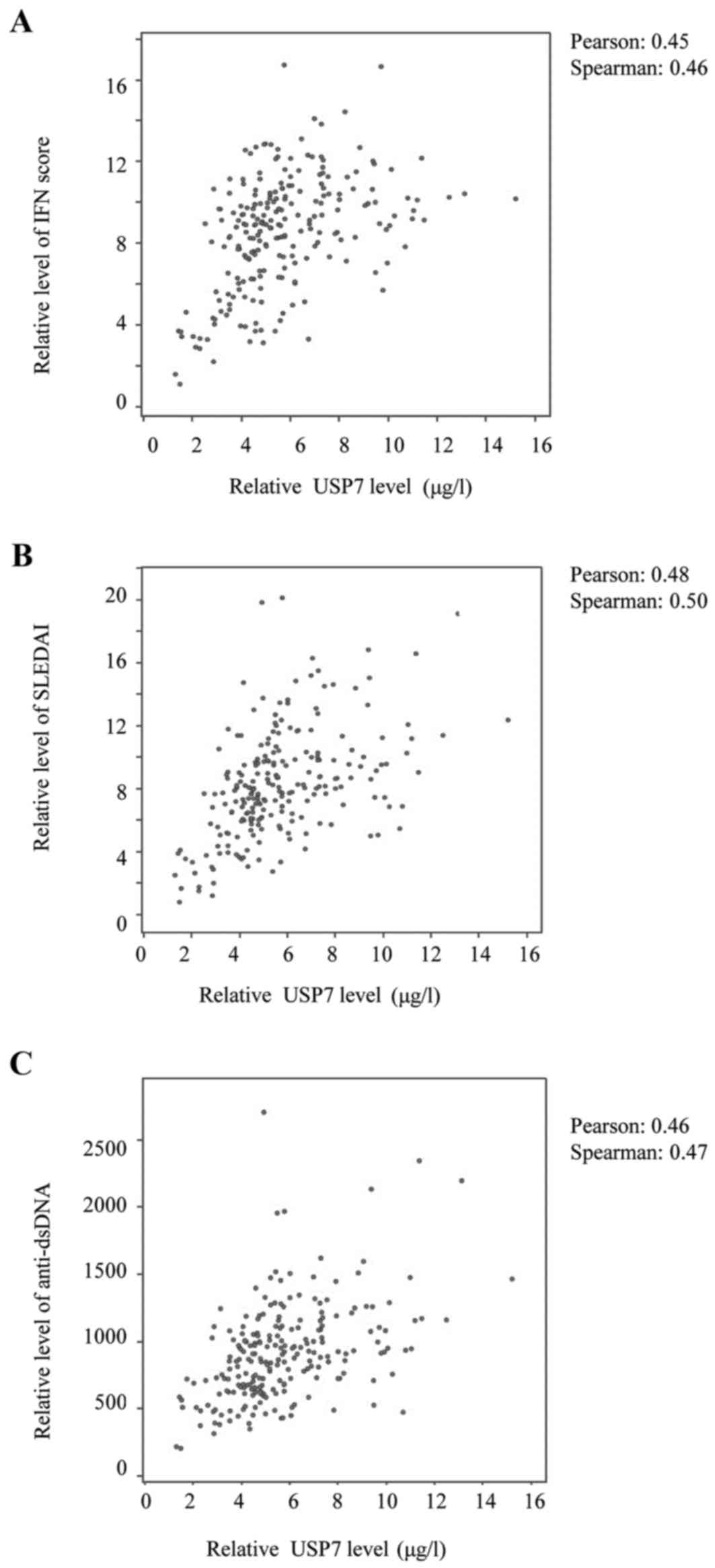USP7 is associated with greater disease activity in systemic lupus erythematosus via stabilization of the IFNα receptor
- Authors:
- Published online on: June 20, 2017 https://doi.org/10.3892/mmr.2017.6819
- Pages: 2274-2280
Abstract
Introduction
Systemic lupus erythematosus (SLE) is a complex systemic autoimmune disease, characterized as a loss of tolerance to nuclear antigens, the deposition of pathogenic autoantibodies and the formation of immune complexes leading to inflammation in multiple organs (1,2). Dysregulated T cells and their associated mechanisms are important in the pathogenesis of this complicated disease. Epigenetic modifications including DNA methylation, histone tail modifications and microRNAs may additionally serve roles in SLE.
The ubiquitin-proteasome and deubiquitination systems are important cellular mechanisms of protein degradation and stabilization, which may influence gene expression and alter cellular functions without modifying the genomic sequence. Understanding the molecular mechanisms that are involved in the pathophysiology of autoimmune diseases is essential for the introduction of effective, target-directed and accepted therapies (3,4).
One notable feature in SLE is the continuous activation of the type I interferon (IFN) system, shared by the majority of SLE patients (5–7). The vascular damage, endothelial progenitor cell misbalance and induced expression of broad signature gene transcripts that reflect induction are primarily due to the central involvement of IFNα (8,9). The type I interferon receptor complex consisting of the human IFN α-2 receptor (IFNAR)1 and IFNAR2 subunits, and cellular responses to IFNα, require adequate expression levels of IFNAR1 (10). It has been reported that IFNAR1 may be ubiquitinated by the Skp1-Cullin1-HOS-Roc1 ubiquitin ligase in vitro (11), however, whether the protein level of IFNAR1 is regulated by the deubiquitination system and whether these deubiquitinating enzymes exhibit a role in the clinical outcomes of SLE patients, remains to be elucidated. The deubiquitinases contain two major groups: the ubiquitin C-terminal hydrolase families and the ubiquitin-specific protease (USP) families. Of the USP families, USP7 is an evolutionarily conserved protease that was first reported in 1997 (12) and was revealed to possess various substrates, including Ci/Gli (13), phosphatase and tensin homolog (14), forkhead box protein O4 (15), histone H2B (16) and tumor protein p53 (17), indicating that USP7 exhibits a role in multiple cellular processes. However, the expression pattern and function of USP7 in SLE progression remains to be elucidated.
The present study demonstrated that IFNAR1 acted as a substrate for USP7, and that USP7 functioned to stabilize IFNAR1, which was responsible for greater disease activity in SLE.
Materials and methods
Patient samples
A total of 210 patients with SLE were recruited from the Chinese Medicine Hospital of Zhejiang (Hangzhou, China) between January 2010 and December 2014; all SLE patients fulfilled the American College of Rheumatology criteria for the disease (18), and gave written informed consent. A further 210 control samples were recruited from the outpatient clinics of the Chinese Medicine Hospital of Zhejiang between January 2010 and December 2014, including those diagnosed as normally healthy or with an unrelated condition. Written informed consent was also obtained from control patients. Patients with other autoimmune diseases including celiac disease, autoimmune hepatitis, sarcoidosis, or autoimmune thyroid disease were excluded from the present study. All procedures were approved by the institutional review board of Jiangsu University. Peripheral blood (5 ml) samples were drawn from healthy donors and SLE patients. The clinical disease activity was measured and assessed according to the SLE disease activity index (DAI) 2000; SLEDAI scores ≥10 were defined as active SLE, while SLEDAI scores <10 were defined as stable disease (19).
Samples of peripheral blood mononuclear cells (PBMCs) for isolating T cells were purified using the Rosette Sep T cell isolation kit by negative selection (cat no. HY2015; HaoYang Biosciences, Tianjin, China). Serum complement 3 and serum complement 4, double stranded (ds)DNA and anti-nuclear antibodies (ANA) were measured in blood samples in the Department of Laboratory Medicine using a EUROIMMUN ANA profile kit (cat no. DL 1590) and the Sprinter XL Immunofluorescence system (both from EUROIMMUN AG, Luebeck, Germany), according to the manufacturer's protocol, at the Chinese Medicine Hospital of Zhejiang.
Reagents and antibodies
The short interfering (si)RNA transfection was performed using Lipofectamine RNAiMAX (Invitrogen; Thermo Fisher Scientific, Inc., Waltham, MA, USA) and cells were transfected at 70% confluence, according to the manufacturer's protocol. The 2 USP7 siRNA oligonucleotide sequences that were used were as follows: siUSP7 1, 5′-CCGGTGTATCTATTGACTGCCCTTTCTCGAGAAAGGGCAGTCAATAGATACATTTTT-3′; siUSP7 2, 5′-CCGGCCTGGATTTGTGGTTACGTTACTCGAGTAACGTAACCACAAATCCAGGTTTTT-3′. USP7-targeting siRNA and non-targeting siRNA (5′-CCGGUUCUCCGAACGUCACGUTTTTTTTT-3′) were obtained from Sigma-Aldrich (Merck KGaA, Darmstadt, Germany).
Antibodies used were as follows: anti-USP7 antibody (cat no. 4833; 1:1,000; Cell Signaling Technology, Danvers, MA, USA), anti-IFNAR1 (cat no. SAB1406003-50UG; 1:1,000; Sigma-Aldrich; Merck KGaA) and anti-β-actin (cat no. 612656; 1:2,000; BD Biosciences, Franklin Lakes, NJ, USA). Horseradish peroxidase-conjugated goat anti-mouse immunoglobulin (Ig)G (cat no. sc-2005; 1:3,000) and goat and anti-rabbit IgG (cat no. sc-2004; 1:3,000) secondary antibodies were obtained from Santa Cruz Biotechnology, Inc. (Dallas, TX, USA).
Cell culture
HEK-293T cells was purchased from American Type Culture Collection (Mannasas, VA, USA) and were cultured in Dulbecco's modified Eagle's medium (Invitrogen; Thermo Fisher Scientific, Inc.) supplemented with 10% fetal bovine serum (Hyclone; GE Healthcare Life Sciences, Logan, UT, USA), 100 U/ml of penicillin, and 100 U/ml of streptomycin (Invitrogen; Thermo Fisher Scientific, Inc.). Cells were maintained at 37°C in a humidified 5% CO2 atmosphere.
RNA isolation and reverse transcription quantitative polymerase chain reaction (RT-qPCR)
Total RNA was isolated using TRIzol® (Invitrogen; Thermo Fisher Scientific, Inc.). cDNA was synthesized from 1 µg of total RNA using reverse transcriptase (Invitrogen; Thermo Fisher Scientific, Inc.) and the cDNA (2 µg) was amplified using the TransStart Top Green qPCR SuperMix kit (cat no. AQ132-23; TransGen, Beijing, China) on an ABI 7500 Real-Time PCR system (Applied Biosystems; Thermo Fisher Scientific, Inc.). GAPDH was used as an internal normalization control. Thermocycling conditions were as follows: Initial denaturation at 95°C for 5 min, followed by 40 cycles of denaturation at 95°C for 10 sec, and annealing and extension at 60°C for 30 sec. The primers used were as follows: GAPDH, forward GAG AAG TAT GAC AAC AGC CTC-3′, reverse 5′-ATGGACTGTGGTCATGAGTC-3′; IFNAR1, forward GAC TCA TTT ACA CCA TTT CGC A-3′, reverse 5′-TCAATCCTTTCTTCTACACCTG-3′; and USP7 forward ATT CCT AAC ATT GCC ACC AG-3′ and reverse 5′-ATTTACACCATTTGCCATCC-3′. Relative gene expression was calculated according to the 2−∆∆Cq method (20) and normalized to GAPDH. All experiments were performed at least three times.
Co-immunoprecipitation (co-IP) assay
Cells were lysed using cold lysis buffer (50 mM Tris-Cl, pH 7.4; 1% NP-40; 150 mM NaCl; 1 mM EDTA; and, 0.5% sodium deoxycholate) and a protease inhibitor cocktail (BD Biosciences) was used to protect cells from degradation. The supernatants of the lysates were incubated with primary antibodies against USP7 and IFNAR1. A total of 2 µg normal rabbit and mouse immunoglobin IgG (cat nos. M8645 and G7402; Sigma-Aldrich; Merck KGaA) were used as negative control and Pierce™ Protein A/G Magnetic Beads (cat no. 88802; Pierce; Thermo Fisher Scientific, Inc.) were added to the immune complexes and incubated for 2 h at 4°C. The immune complexes were washed 5 times, subjected to SDS-PAGE and detected by western blot analysis.
Western blot analysis
Protein extracts were lysed with a radioimmunoprecipitation assay buffer (Sigma-Aldrich; Merck KGaA) containing phenylmethane sulfonyl fluoride and a protease inhibitor cocktail for 30 min at 4°C, and following centrifugation at 12,000 × g for 15 min at 4°C, the supernatants were collected. Equal amounts of extracted protein samples (25 µg) were resolved by 10% SDS-PAGE and transferred onto nitrocellulose membranes, followed by blocking with 5% non-fat milk for 30 min at room temperature and incubation at 4°C overnight with anti-USP7, anti-IFNAR1 and anti-β-actin primary antibodies. Membranes were then incubated with horseradish peroxidase-conjugated secondary antibodies for 2 h at room temperature. Protein bands were visualized using an enhanced chemiluminescence assay system (Sigma Aldrich; Merck KGaA). The experiments were repeated at least three times.
Glutathione S-transferase (GST) pull down analysis
To detect in vitro binding between USP7 and IFNAR1, the GST fusion construct GST-USP7 was purified from BL21 Escherichia coli cells (TransGen), as previously described (21). The in vitro transcription and translation of FLAG-tagged IFNAR1 was obtained from the rabbit reticulocyte lysate (TNT systems, Promega Corporation, Madison, WI, USA) and pulled down with glutathione-Sepharose beads (GE Healthcare Life Sciences, Little Chalfont, UK), according to the manufacturer's protocol.
Statistical analysis
Statistical analysis was performed using SPSS software version 17.0 (SPSS, Inc., Chicago, IL, USA). All data were presented as the mean ± standard deviation, unless otherwise stated, of one representative of three experiments. Spearman's rank correlation was used to measure correlations between patient variables and SLE presence or activity. A paired Student's t-test was used to perform the analysis. P<0.05 was considered to indicate a statistically significant difference.
Results
The clinical characteristics in patients with SLE and healthy controls
As demonstrated in Table I, no significant differences were observed in age or sex distribution between the SLE patients and healthy controls. The 210 SLE patients were positive for ANA, whereas the controls were negative; the proportion of lymphocytes was significantly lower in patients compared with the control, while the difference in the average number of total white blood cells was not deemed significant. As mentioned, an SLEDAI score ≥10 was considered as active SLE and there were 103 (49.05%) active patients and 107 (50.95%) stable patients. As demonstrated in Table II, no significant differences were observed in age or sex distribution between these two groups. The differences in SLEDAI score, dsDNA positivity and levels of complement 3 and 4 were significant between the two groups (P<0.05).
Higher USP7 expression is observed in patients with SLE
The deubiquitinases take part in numerous cellular processes, but very little is known concerning the role of USPs in immune cells and specifically in T cells. In the present study, the mRNA expression level of different USP proteins between SLE and the healthy controls was screened. The expression levels of three USP proteins (USP7, USP10 and USP21) were higher in SLE patients compared with controls (data not shown). Among the USP proteins, the expression of USP7 in samples obtained from the 210 SLE patients was the most significantly upregulated compared with the normal controls (Fig. 1A). The role of USP7 in SLE was explored and analysis performed to measure whether there was any correlation between USP7 levels and the clinical features of SLE. As demonstrated, the high USP7 expression correlated positively with SLE cutaneous manifestations including the presence of skin, renal and neurological diseases (Fig. 1B). SLE patients with concurrent proteinuria had higher USP7 levels compared with those without proteinuria (Fig. 1C).
IFNAR1 identifies as a USP7-interacting protein
One of the biggest challenges in studying USP families is to identify their substrate and to correlate their dysregulation with pathogenesis. Affinity purification and mass spectrometry were used to detect the USP7 association proteins in vivo (data not shown). IFNAR1 was identified as a USP7-interacting protein. To further confirm the interaction between USP7 and IFNAR1 in vivo, a co-IP assay was performed in T cells and total protein extracted, IP with USP7 antibodies followed by immunoblotting (IB) with the antibodies against IFNAR1 indicated that USP7 co-immunoprecipitated with IFNAR1; normal rabbit IgG was used as a negative control (Fig. 2A). Reciprocally, IP was performed with anti-IFNAR1 followed by IB with anti-USP7 (Fig. 2A bottom panel). To further support the in vivo interaction between USP7 and IFNAR1, endogenous proteins from HEK-293T cells were used to confirm the interaction (Fig. 2B).
Other USP proteins including USP10 and USP21 were additionally detected; neither had any interaction with IFNAR1, and data was not shown. To further confirm the interaction between IFNAR1 and USP7 in vitro, GST pull down assay was performed and incubation of GST-fused USP7 with in vitro transcribed/translated IFNAR1 revealed that USP7 interacted with IFNAR1 directly (Fig. 2C).
USP7 inhibits IFNAR1 ubiquitination and stabilizes IFNAR1 in vivo
In SLE patients, it was hypothesized that USP7 regulated IFNAR1 expression in T cells and higher USP7 expression contributed to the observed elevated IFNAR1 expression. Therefore, human primary T cells were transfected with USP7 siRNAs, control siRNAs, USP7 overexpression lentivirus or vector lentivirus. The successful knockdown efficiency (Fig. 3A) and ectopic expression of USP7 (Fig. 3B) in primary T cells was verified by RT-qPCR and western blot analysis, which demonstrated that the knockdown of USP7 following transfection resulted in a significant decrease in USP7 expression, while the overexpression of USP7 lentivirus resulted in a clear increase in USP7 expression.
Following USP7 knock down, the expression of IFNAR1 was measured and although the IFNAR1 mRNA level was not changed (Fig. 3C, left), the IFNAR1 protein level was markedly reduced (Fig. 3C, right). Consistently, when wild-type (wt) USP7 lentivirus or catalytically inactive USP7 (USP7/C223A) mutant lentivirus was transfected into the cells, the protein level of IFNAR1 increased in wt-USP7 transfected groups, but not in the catalytically inactive USP7 (USP7/C223A) mutant groups (Fig. 3D); the two groups demonstrated no remarkable change in the mRNA level. This indicated that USP7 may influence IFNAR1 through post-transcription modification.
To determine whether the effect of USP7 was dependent on IFNAR1 protein deubiquitination, USP7 was knocked down by siRNA and cells were harvested following MG132 (a proteasome-specific inhibitor) treatment; it was demonstrated that MG132 was successful in saving IFNAR1 protein from degradation in USP7 knockdown groups compared with the control groups (Fig. 3E). Based on the above, it was hypothesized that USP7 stabilized IFNAR1, as it protected the protein from ubiquitination.
Effects of USP7 on activation of the IFNα pathway
Whether sustained overexpression of USP7 was able to induce the activation of the type I IFN pathway in SLE patients was explored. The activation of STAT proteins was a response to type I IFN, since the IFN-stimulated transcription factor 3 complex contained three core subunits that activated STAT-1 and STAT-2 in addition to interferon regulatory factor (IRF)-9, the function of which is to initiate transcription of IFN-inducible genes. It was next considered whether USP7 regulated downstream target transactivation following stimulation with type I IFN. As demonstrated from mRNA and protein levels in Fig. 4A and B, normal PBMCs were transfected and stimulated with type I IFN, and knockdown of USP7 consistently reduced the expression of STAT-1 and STAT-2.
Furthermore, knockdown of USP7 notably reduced the mRNA (Fig. 4C) and protein expression levels (Fig. 4D) of selected IFN-inducible genes, including IFN-induced protein with tetratricopeptide repeats 3 (IFIT3), myxovirus resistance 1 (MX1) and 2′,5′-oligoadenylate synthetase 1 (OAS1).
Correlation between USP7 expression and SLE disease activity
It has been reported by several groups (22,5) that type I IFN exhibits a key etiological role in SLE since, by stabilizing IFNAR1, USP7 may reflect defects in positive regulation of the immune response. The associations were therefore analyzed and, as expected, a positive correlation was identified between USP7 levels and IFN scores (Fig. 5A).
A direct positive correlation was observed between USP7 levels and the SLEDAI scores (Fig. 5B), and between the USP7 levels and the anti-dsDNA levels (Fig. 5C). Furthermore, the IFN level also correlated positively with SLEDAI scores and the anti-dsDNA levels (data not shown); the study conducted by Dall'era et al (23) reported a similar tendency. It was concluded that USP7 expression levels correlate positively with SLE disease activity via stabilization of IFNAR1.
Discussion
Increasing evidence has indicated that IFNα is associated with the progression of several diseases and may serve as a target for therapy. The role of the USP family in autoimmunity is only just beginning to be explored.
The results of the present study established that USP7 is upregulated in patients with SLE, and that greater expression of USP7 was associated with skin, renal and neurological diseases. SLE patients with concurrent proteinuria had higher USP7 levels than those without, which indicated that greater USP7 levels may result in organ damage.
Furthermore, investigation provided insight into the mechanism of the regulation by USP7; bioinformatics tools were used to search for its potential association with the key components involved in SLE (5), and this led to the identification of IFNAR1 as a potential USP7 interaction protein. As it was hypothesized that USP7 interacted with IFNAR1 in vivo and in vitro, co-IP and GST-pull down assays were used to confirm that USP7 disassembled IFNAR1-dependent poly-ubiquitin chains and stabilized IFNAR1 in vivo. As the type I IFN pathway has been reported as a significant contributor to the pathogenesis of SLE (5), the activation effects of USP7 on the IFNα pathway were investigated. When USP7 was knocked down, the signaling downstream of IFN, including the expression of STAT-1, STAT-2 and its predicted IFN-inducible genes (IFIT3, MX1 and OAS1), were downregulated. For the first time, to the best of the authors' knowledge, it has been demonstrated that USP7 is significantly overexpressed in SLE patients compared with healthy controls. Furthermore, a positive correlation was observed between USP7 levels, IFN scores, SLEDAI scores and anti-dsDNA, which indicated that the activation of the type I IFN pathway in SLE patients is due to USP7 over-activation in the pathogenesis of autoimmune conditions. In conclusion, the results of the present study demonstrated that the overexpression of USP7 is relevant to the biologic and clinical behavior of SLE. The findings suggested that the USP family may serve as therapeutic targets via regulation of IFNAR1 for the treatment of SLE. In the future, knockout and transgenic animal models will be required to further identify the role of USP7 in autoimmune diseases.
References
|
Tsokos GC: Systemic lupus erythematosus. N Engl J Med. 365:2110–2121. 2011. View Article : Google Scholar : PubMed/NCBI | |
|
Gillis JZ, Panopalis P, Schmajuk G, Ramsey-Goldman R and Yazdany J: Systematic review of the literature informing the systemic lupus erythematosus indicators project: Reproductive health care quality indicators. Arthritis Care Res (Hoboken). 63:17–30. 2011. View Article : Google Scholar : PubMed/NCBI | |
|
Hedrich CM and Tsokos GC: Epigenetic mechanisms in systemic lupus erythematosus and other autoimmune diseases. Trends Mol Med. 17:714–724. 2011. View Article : Google Scholar : PubMed/NCBI | |
|
Qu B and Shen N: miRNAs in the pathogenesis of systemic lupus erythematosus. Int J Mol Sci. 16:9557–9572. 2015. View Article : Google Scholar : PubMed/NCBI | |
|
Crow MK: Advances in understanding the role of type I interferons in systemic lupus erythematosus. Curr Opin Rheumatol. 26:467–474. 2014. View Article : Google Scholar : PubMed/NCBI | |
|
Thacker SG, Zhao W, Smith CK, Luo W, Wang H, Vivekanandan-Giri A, Rabquer BJ, Koch AE, Pennathur S, Davidson A, et al: Type I interferons modulate vascular function, repair, thrombosis, and plaque progression in murine models of lupus and atherosclerosis. Arthritis Rheum. 64:2975–2985. 2012. View Article : Google Scholar : PubMed/NCBI | |
|
Lee PY, Li Y, Richards HB, Chan FS, Zhuang H, Narain S, Butfiloski EJ, Sobel ES, Reeves WH and Segal MS: Type I interferon as a novel risk factor for endothelial progenitor cell depletion and endothelial dysfunction in systemic lupus erythematosus. Arthritis Rheum. 56:3759–3769. 2007. View Article : Google Scholar : PubMed/NCBI | |
|
Denny MF, Thacker S, Mehta H, Somers EC, Dodick T, Barrat FJ, McCune WJ and Kaplan MJ: Interferon-alpha promotes abnormal vasculogenesis in lupus: A potential pathway for premature atherosclerosis. Blood. 110:2907–2915. 2007. View Article : Google Scholar : PubMed/NCBI | |
|
Reynier F, Petit F, Paye M, Turrel-Davin F, Imbert PE, Hot A, Mougin B and Miossec P: Importance of correlation between gene expression levels: Application to the type I interferon signature in rheumatoid arthritis. PLoS One. 6:e248282011. View Article : Google Scholar : PubMed/NCBI | |
|
Müller U, Steinhoff U, Reis LF, Hemmi S, Pavlovic J, Zinkernagel RM and Aguet M: Functional role of type I and type II interferons in antiviral defense. Science. 264:1918–1921. 1994. View Article : Google Scholar : PubMed/NCBI | |
|
Kumar KG, Tang W, Ravindranath AK, Clark WA, Croze E and Fuchs SY: SCF(HOS) ubiquitin ligase mediates the ligand-induced down-regulation of the interferon-alpha receptor. EMBO J. 22:5480–5490. 2003. View Article : Google Scholar : PubMed/NCBI | |
|
Everett RD, Meredith M, Orr A, Cross A, Kathoria M and Parkinson J: A novel ubiquitin-specific protease is dynamically associated with the PML nuclear domain and binds to a herpesvirus regulatory protein. EMBO J. 16:1519–1530. 1997. View Article : Google Scholar : PubMed/NCBI | |
|
Zhou Z, Yao X, Li S, Xiong Y, Dong X, Zhao Y, Jiang J and Zhang Q: Deubiquitination of Ci/Gli by Usp7/HAUSP regulates hedgehog signaling. Dev Cell. 34:58–72. 2015. View Article : Google Scholar : PubMed/NCBI | |
|
Song MS, Salmena L, Carracedo A, Egia A, Lo-Coco F, Teruya-Feldstein J and Pandolfi PP: The deubiquitinylation and localization of PTEN are regulated by a HAUSP-PML network. Nature. 455:813–817. 2008. View Article : Google Scholar : PubMed/NCBI | |
|
van der Horst A, de Vries-Smits AM, Brenkman AB, van Triest MH, van den Broek N, Colland F, Maurice MM and Burgering BM: FOXO4 transcriptional activity is regulated by monoubiquitination and USP7/HAUSP. Nat Cell Biol. 8:1064–1073. 2006. View Article : Google Scholar : PubMed/NCBI | |
|
van der Knaap JA, Kumar BR, Moshkin YM, Langenberg K, Krijgsveld J, Heck AJ, Karch F and Verrijzer CP: GMP synthetase stimulates histone H2B deubiquitylation by the epigenetic silencer USP7. Mol Cell. 17:695–707. 2005. View Article : Google Scholar : PubMed/NCBI | |
|
Li M, Chen D, Shiloh A, Luo J, Nikolaev AY, Qin J and Gu W: Deubiquitination of p53 by HAUSP is an important pathway for p53 stabilization. Nature. 416:648–653. 2002. View Article : Google Scholar : PubMed/NCBI | |
|
Hochberg MC: Updating the American College of Rheumatology revised criteria for the classification of systemic lupus erythematosus. Arthritis Rheum. 40:17251997. View Article : Google Scholar : PubMed/NCBI | |
|
Gladman DD, Ibañez D and Urowitz MB: Systemic lupus erythematosus disease activity index 2000. J Rheumatol. 29:288–291. 2002.PubMed/NCBI | |
|
Livak KJ and Schmittgen TD: Analysis of relative gene expression data using real-time quantitative PCR and the 2(−Delta Delta C(T)) method. Methods. 25:402–408. 2001. View Article : Google Scholar : PubMed/NCBI | |
|
Einarson MB, Pugacheva EN and Orlinick JR: GST Pull-down. CSH Protoc. 2007:pdb prot47572007.PubMed/NCBI | |
|
Zhang ZM, Rothbart SB, Allison DF, Cai Q, Harrison JS, Li L, Wang Y, Strahl BD, Wang GG and Song J: An allosteric interaction links USP7 to deubiquitination and chromatin targeting of UHRF1. Cell Rep. 12:1400–1406. 2015. View Article : Google Scholar : PubMed/NCBI | |
|
Dall'era MC, Cardarelli PM, Preston BT, Witte A and Davis JC Jr: Type I interferon correlates with serological and clinical manifestations of SLE. Ann Rheum Dis. 64:1692–1697. 2005. View Article : Google Scholar : PubMed/NCBI |



